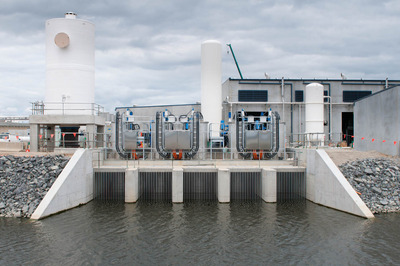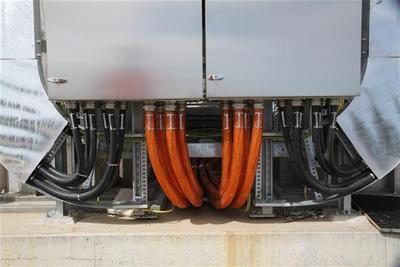Melbourne Water’s treatment plant upgrade
Friday, 30 November, 2012
Following 13 months of critical execution to keep complete functionality of Melbourne Water’s Western Treatment Plant that processes more than 52% of Melbourne’s wastewater, engineering solutions provider O’Donnell Griffin completed the electrical works component of the wet weather upgrade project in December 2011.
In August 2011, O’Donnell Griffin also secured the LV Installation Package (Northern) contract as part of Melbourne Water’s Eastern Treatment Plant Tertiary Upgrade Project. The company has already won the NECA Victoria Industrial Project - Large category for the project. “The company used specialised equipment and systems to create an outstanding plant,” said NECA.
The project was a part of the plant’s $418 million transformation into one of the most sophisticated, large-scale sewage treatment facilities in the world. The transformation is being delivered by the Eastern Tertiary Alliance - a partnership between Baulderstone, UGL, Black & Veatch, KBR and Melbourne Water. Since its opening in 1975, the Eastern Treatment Plant has supported Melbourne Water’s Western Treatment Plant by treating 40% of Melbourne’s total sewage to a ‘secondary standard’ in a process that involves screening and sedimentation to remove litter, grit and sludge, followed by biological treatment and disinfection with chlorine.
The current upgrade involves the construction of seven new structures, including the ozone production facility, and an addition of a third ‘advanced tertiary’ treatment stage. Tertiary treatment uses ozone - generated on-site from oxygen - to disinfect the effluent and reduce colour and odour. Biological filters then break down any organic matter and reduce contaminants such as ammonia, foam, grease and litter before more ozone is added and ultraviolet light is used to further disinfect the effluent. The project is expected to deliver significant environmental benefits by improving the quality of the plant’s discharge at Boags Rocks, on the Mornington Peninsula, and increasing the standard of recycled water produced at the plant.

This project had a limited time frame prior to commencement on-site. Upon appointment, O’Donnell Griffin was quickly required to allocate all resources and facilities to complete electrical works at the newly constructed ozone production facility. O’Donnell Griffin allocated an on-site management team, a suitable number of capable and experienced resources, and plant and equipment. It was a challenge but the company achieved it successfully. It also meant the company had to monitor its resources constantly to ensure all demands were always met with an adequate supply. O’Donnell Griffin completed the LV Installation Package (Northern) contract in April 2012 - on time, within budget and with zero lost time incidents (LTI).
The scope of works required O’Donnell Griffin to supply all labour, plant, equipment, administration, consumables, supervision and verification necessary to carry out the LV Installation Package (Northern) works. Initially based on preliminary cable ladder routes, cable schedules and power/lighting layout designs, the scope was ultimately divided into two key areas - the Ozone Area and the TSPS Area.
Forming part of the Ozone Area were: LV and HV switchrooms, a PLC room, UPS room and control room; a cooling water pump station - to provide cooling water for the removal of heat from the ozone and oxygen generation process; a liquid oxygen area - to store the backup source for the ozone generation process; a pre-ozone injection area, post-ozone injection area, contractor area and ozone destruction skid - to manage all stages of ozone injection; generator room - to convert oxygen gas into a low concentration ozone mixture. The Ozone Area also included variable pressure swing adsorption (VPSA) rooms 1 and 2 to serve as the primary oxygen generation equipment, purifying ambient air to produce oxygen gas and a pump room to house the cooling systems for the oxygen and ozone generation process, as well as the plant instrument air system.The TSPS Area comprised a switchroom and a PLC room, together with a primary pump station which extracted semi-treated water from the forebay and pumped the water into the tertiary filtration plant.

In delivering the detailed scope of works, O’Donnell Griffin managed, installed, tested and commissioned all 400 V switchgear and associated 6.6 kV switchgear as well as PLC/communication panels, vendor-supplied control equipment, motors, local control stations, field instrumentation and communication systems. Using an extensive, pre-installed underground and in-slab conduit system, the team was principally challenged to install and test approximately 1800 associated electrical cables. This was achieved through a highly coordinated process of guiding the supplied cables to the selected location, opening pits, installing the cables and rescheduling other works to ensure continuity of work. Most instrumentation and wet racks were also installed, wired, tubed and calibrated.
Additionally, the team was responsible for the installation and termination of various systems and networks, from the variable speed drives, earthing systems, distribution boards and Profibus communications network to the light and power system, and UPS and battery charger systems. Each piece underwent testing and certification prior to its installation.
While the general electrical design of the project was supplied to the team, O’Donnell Griffin was instrumental in assisting to identify, recommend and resolve the best on-site installation methods. The technical elements of this project were complemented by O’Donnell Griffin’s ability to provide the essential management services necessary to successfully deliver the project requirements.
The greatest difficulty encountered by O’Donnell Griffin was the scheduling of works, as is typical of a large-scale, multidisciplinary project. The team was required to continually maintain suitable manning levels to achieve measured milestones. The company’s customer held management meetings on a weekly basis to ensure a constant flow of information was achieved with all stakeholders. Combined with two-week forecasts and a detailed project timeline, the regular communication ensured no unscheduled electrical and mechanical service interruptions occurred on-site throughout the entire seven months of installation works.
Encore Tissue improves plant reliability with new DCS
An Australian toilet paper and paper towel manufacturer needed a modern DCS solution that would...
Data-driven insights: how AI is transforming industrial processes
Although most of the underlying mathematics of control systems stems from the 1960s, it has only...
From smart to vulnerable: The hidden costs of the digitalisation of utilities
For Australia’s critical infrastructure sectors proactive investment in cybersecurity is no...











